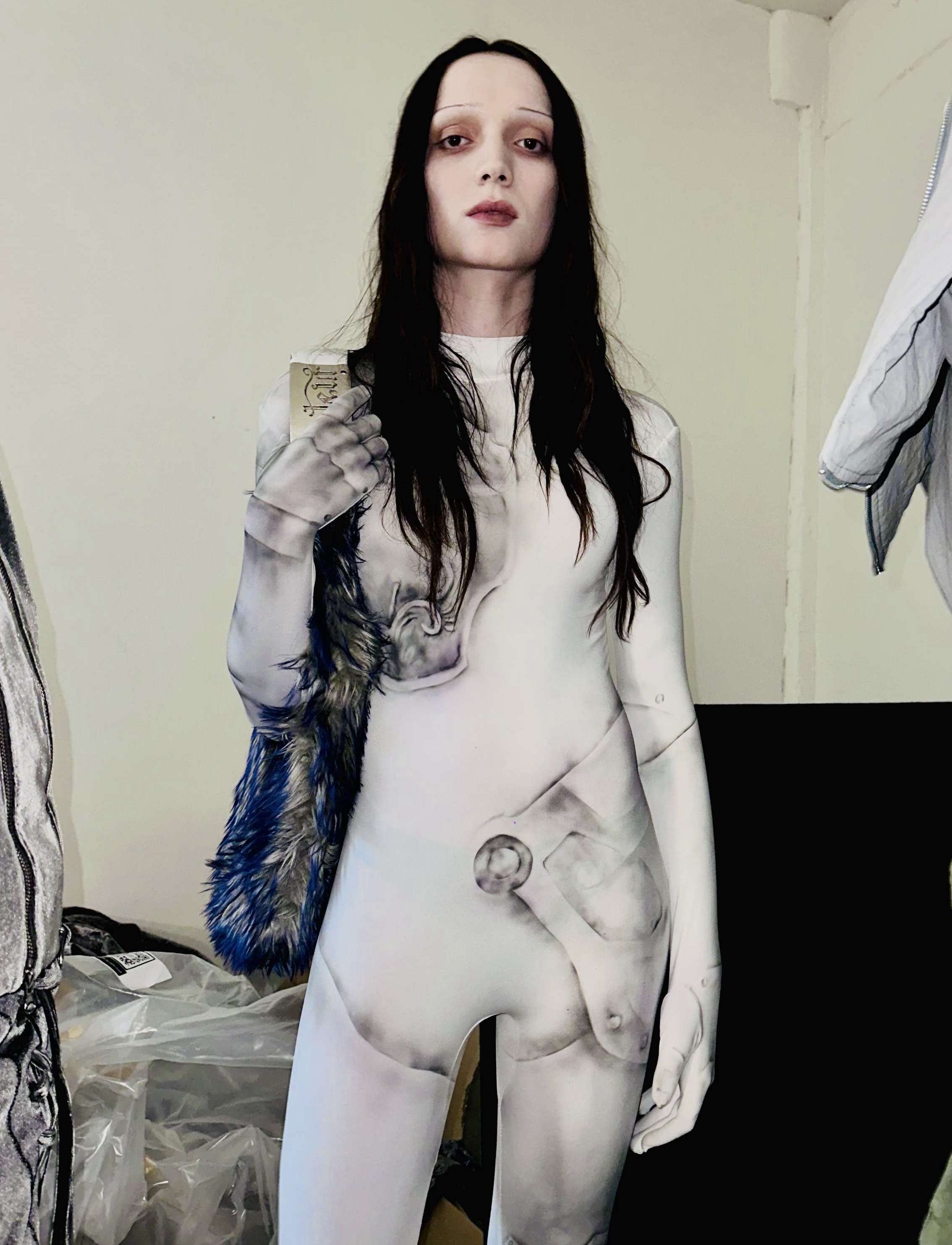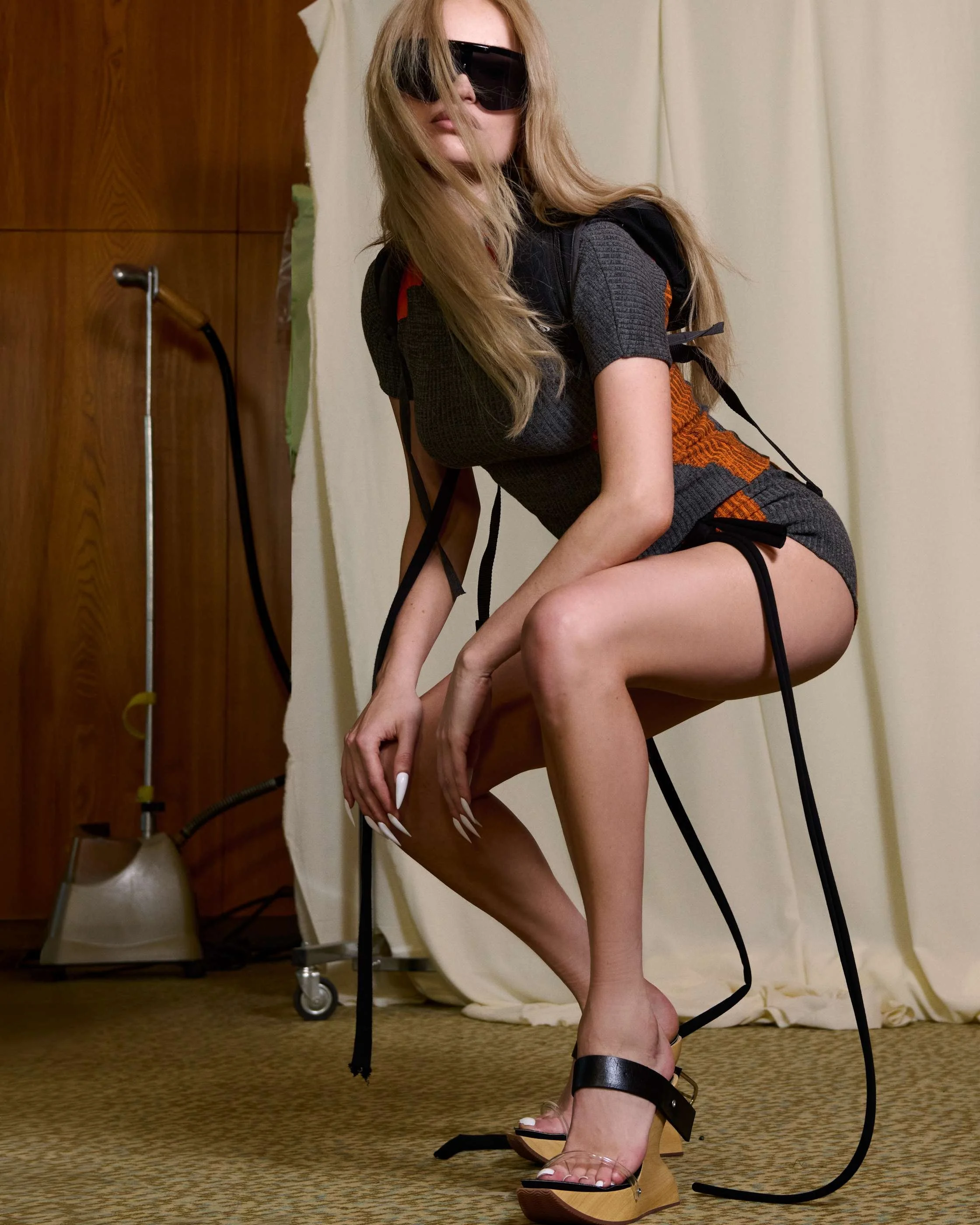Berlin Fashion Week Fall Winter 2025
Berlin Fashion Week has never been about tradition. Founded in 2007, it exists in contrast to the long-established circuits of Paris, Milan, London, and New York. That difference defines it, forcing designers to think not just about garments but about impact. The Fall/Winter 2025–26 season made that especially clear.
This time, collections reflected the full breadth of what Berlin fashion has become. Some designers leaned into the city’s reputation for stark, utilitarian aesthetics, while others built collections around personal storytelling. Some engaged with political and social themes, while others borrowed from pop culture, using familiarity as a means of accessibility. But one element connected them all: the need to be seen.
In a week dominated by smaller brands, visibility becomes the highest currency. And so, Berlin Fashion Week has embraced the logic of digital spectacle. Berlin may not have the weight of legacy behind it, but that has never been its ambition. What it does have is momentum and the sense that, season by season, it’s rewriting the rules.
SIA ARNIKA
Sia Arnika's "Harbour Bitch" collection, a highlight of Berlin Fashion Week, pays homage to a powerful woman from her childhood on the island of Mors. Arnika reimagines aesthetic codes deeply connected to her past, including the workwear of Mors' fishermen: technical fabrics, tartan patterns, polo shirts, and fishing nets. These fundamental pieces are reconstructed with a "post-human" sensibility, altering the body's form through sculptural volumes, hard geometric shapes, and three-dimensional textures. The show's environment, created by Berlin's TOR Studio, contrasts organic components like sea foam and algae (some brought from Mors by Arnika's parents) with inorganic materials such as plastics and buoys within a factory space.
GMBH
Serious times call for serious clothes. GmbH’s Fall/Winter 2025 collection, From Another Reality, was a meditation on loss, dignity, and the quiet power of craft. In a world that feels increasingly fractured, Benjamin A. Huseby and Serhat Işık turned inward, not out of nostalgia, but to reclaim a sense of stability. Their response was one of precision tailored suits with rigid shoulders, weightless organza, and the stark contrast of thigh-high leather boots.
At the show’s midpoint, the runway went dark, and the voice of Norwegian modernist poet Gunvor Hofmo filled the space. Her 1947 poem, also titled From Another Reality, spoke of parallel worlds of people living through the same events yet perceiving them differently. This moment, rare in its restraint, underscored the designers’ intent. Fashion, to them, is not escapism but a way to address the present without losing sight of craft’s fundamental human aspect.
“In serious times and we are living in very serious, even terrifying times fashion can seem frivolous. How can creativity survive under such conditions? How can we find purpose in our work as fashion designers?”
The collection shifted after this pause schoolboy shorts, university crests, political slogans, and crimson overcoats replaced the earlier severity. It was a deliberate contrast, reinforcing the tension between structure and chaos, past and present. “We always try to make fashion that has a purpose,” Huseby said after the show. That purpose, this season, was clear: to create clothing that carries weight, even in the face of uncertainty.
LUEDER
LUEDER’s The Shell is a study in contrasts, ornate and raw, historical and futuristic, intimate yet imposing. Presented at INTERVENTION III during Berlin Fashion Week, the collection constructs a world where voyeurism and self-expression collide, where individuals oscillate between hiding and revealing themselves.
Marie Lueder continues her ongoing exploration of archetypes, conjuring figures like the hooligan, the decadent romantic, and the undead teenager. These characters navigate a world that feels like a forgotten ballroom repurposed for a rave, 19th-century tapestries and carpet prints clashing with underground rebellion. The past lingers, distorted, as if viewed through surveillance footage or a dream remembered incorrectly.
The set amplifies this uncanny tension. Black-and-white images of LUEDER’s community, half-mugshot, half-ghostly apparition, cover custom carpets. Tym Novikov’s chandeliers cast fractured light across the space, while Simon Parris’ sound design layers drone hums with a heartbeat-like ticking and spectral vocals. The atmosphere is thick with both nostalgia and unease.
KASIA KUCHARSKA
Kasia Kucharska’s Fall/Winter 2025 collection turns the mechanics of garment-making inside out. Fabric is not sewn but printed, structure is built through ornament, and latex becomes both material and method. This is not about decoration, it is about engineering confidence, reshaping silhouettes, and rethinking the framework of clothing itself.
The collection reflects a return to craftsmanship, though not in any nostalgic sense. Instead, it distorts familiarity, preppy knit sweaters are dismantled, reassembled, and rendered unrecognizable. Latex lace replaces traditional stitching, turning garments into seamless constructions where function and ornament collapse into one. Dresses hold together through tension rather than thread, existing in a space between reality and illusion.
What emerges is a new kind of sophistication, one that plays with perception. These garments suggest control but resist restriction, embracing a fluidity that feels both futuristic and instinctive. Fashion, here, becomes an act of transformation, not just in how garments are made, but in how they make the wearer feel.
ANDREJ GRONAU
Andrej Gronau’s Fall/Winter 2025 collection moves through a world of forgotten objects, trinkets left on shelves, heirlooms that have outlived their owners, ornaments that serve no function beyond their own quiet charm. These pieces, discarded or overlooked, hold a strange power: not in their material worth, but in the way they collect memory, meaning, and sentiment over time.
This collection turns that sentiment into form. Wrinkled metallics shape jackets like gilded relics, delicate knits mimic unraveling ribbons, and oversized collars nod to antique porcelain figurines. The tension between the playful and the sophisticated runs throughout, furry textures evoke childhood comforts, while crisp tailoring holds it all in balance. The result is a wardrobe that drifts between the past and the present, between fantasy and function.
Here, beauty is not polished or perfected. It exists in what is unfinished, what is flawed, what has lived. Rhinestones, tinsel, and fake pearls glimmer without pretense, their charm resting not in their cost but in the feeling they provoke. This is clothing as recollection, as an object to be treasured, not for what it can do, but for what it can make you remember.
LOU DE BÈTOLY
Luxury often begins where others see nothing at all. This collection pulls from what has been left behind, worn fabrics, broken objects, overlooked materials and reworks them into pieces that balance intuition with precision.
Silk nightgowns, gathered and pleated by hand, flow over the body with liquid ease. Lace bras, once delicate underpinnings, are reconstructed into sculptural bodices. Pink bed sheets, stripped from a former set, take on unexpected volume, mimicking fur in tailored suits. Even discarded bike reflectors, collected from Berlin’s streets, find their way into shimmering halter tops.
The pieces shift between refinement and rawness. A vintage silk blanket, hand-beaded over time, becomes an evening gown. Leather belts, cut and rewoven, hold their history while taking on a new form. Mohair threads through sheer nylon like an abstract painting in motion. Decomposing lace clings to bridal silhouettes, turning fragility into ornament. Even the smallest details, chicken feathers from the designer’s childhood home, carry a weight beyond their appearance.
HADERLUMP
HADERLUMP didn’t simply reference the past, it moves through it. With SOLIVAGANT, Johann Ehrhardt distills the transient beauty of train travel into a collection that speaks in textures, silhouettes, and the subtle weight of nostalgia.
The show’s settin, a steel-clad industrial hall, set the tone for an atmosphere both grand and intimate. Models walked with a sense of purpose, embodying travelers caught between departure and destination. Wool and denim, nodding to train upholstery and uniforms, were meticulously reworked, while a restrained palette of black, grey, and blue carried a sense of quiet sophistication. Red accents, bold, deliberate, marked the collection like signals on a railway track.
Structure remained key. Coats and tailored suits borrowed from mid-century formality, yet details, unexpected draping, sharp juxtapositions, kept them anchored in the present. HADERLUMP’s signature craftsmanship held steady, but this season, a new conversation emerged: one between past and present, solitude and motion, nostalgia and reinvention.
Repurposed materials played a crucial role. Fabrics sourced from eBay arrived with their own stories, now reworked into something undeniably contemporary. A stroller, designed by Marian Herget, served as an artifact of movement, reimagined for a different time.
RICHERT BEIL
Richert Beil’s Mutter does not comfort, it confronts. The collection unravels the unseen weight of care and responsibility, translating emotional and physical exhaustion into a tactile language of tension and restraint.
From the first look, the mood was clear. Models moved with the heaviness of a long day stretched into a lifetime. Silhouettes exaggerated presence, oversized outerwear swelling beyond the body, stiff fabrics pressing against the skin. Fluid jerseys and delicate silk-cotton blends whispered of ease but never offered escape. Latex clung, a reminder of obligations impossible to shed.
The maternal figure at the heart of the collection extended beyond literal interpretation. Instead, Mutter spoke to the burden of expectation, the quiet strain of keeping everything together. Garments sagged under their own weight, sleeves stretched past reach, coats wrapped and restricted in equal measure.
This was not a lament. It was a statement, sharp, undeniable, and deeply felt. Richert Beil does not just dress the body. Here, the body wears the weight of reality.
OBS
Inside St. Elisabeth Church, the quiet hum of craftsmanship filled the space. OBS staged its Berlin Fashion Week debut with the clarity and precision of a blueprint, each look a structural element, each movement deliberate.
Johannes and Matthias Schweizer do not deal in ornamentation. Their approach is exacting, built from the ground up like the construction sites that shaped their early years. Workwear is not a reference for them, it is a foundation, a necessity.
Leather and organic textiles formed the backbone of the collection. Sturdy, pragmatic, and efficient, the garments held their own weight. Jackets cut like industrial aprons, overalls built with an architect’s logic, accessories designed to carry tools rather than trends. OBS operates outside the cycle of fleeting aesthetics. Its colors, borrowed from construction sites, remain sharp and essential.
This was not a fashion show in the traditional sense. It was a study in function, in material intelligence, in the idea that clothing is not just worn but used. OBS does not dress a person, it equips them.
words DONALD GJOKA
What to read next

















































































































































































